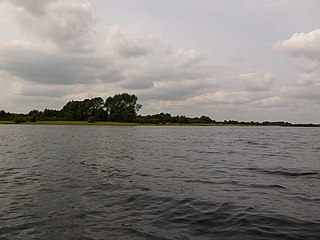The Culdees were members of ascetic Christian monastic and eremitical communities of Ireland, Scotland, Wales and England in the Middle Ages. Appearing first in Ireland and then in Scotland, subsequently attached to cathedral or collegiate churches; they lived in monastic fashion though not taking monastic vows.

Inis Cathaigh or Scattery Island is an island in the Shannon Estuary, Ireland, off the coast of Kilrush, County Clare. The island is home to a lighthouse, a ruined monastery associated with Saints Senan and Canir, an Irish round tower and the remains of an artillery battery. The last residents left in 1969. Most of the island is now owned by the Office of Public Works, who run a small visitor centre and carry out repairs and maintenance on the island; it was bought by Dúchas in 1991.The Irish name Inis Cathaigh was formerly anglicised Iniscathy, which later became Iniscattery and finally Scattery.
Senán mac Geircinn was an Irish Christian minister. He was a resident of Munster and is important in Irish tradition, as founder of Inis Cathaigh and patron of the Corco Baiscinn and the Uí Fhidgeinte. He is listed among the Twelve Apostles of Ireland.

January 27 - Eastern Orthodox liturgical calendar - January 29
Saint Felim, an Irish Christian hermit and priest, was born, probably in Kiennacta Breagh, County Meath in the mid sixth century.

Olcán is the name of an early Irish saint of the Dál Riata, disciple of St Patrick, founder and bishop of the monastery in Armoy in northeast County Antrim, Northern Ireland.

The Twelve Apostles of Ireland were twelve early Irish monastic saints of the sixth century who studied under St Finnian at his famous monastic school Clonard Abbey at Cluain-Eraird, now Clonard in County Meath.
Saint Diarmaid the Just was a Catholic abbot of Inis Clothrann (Inchcleraun), Lough Ree, County Longford and of Faughalstown, County Westmeath and a famous Irish confessor of the late-sixth century.

St. Sennen's Church, Sennen is a parish church in the Church of England located in Sennen, Cornwall, England, UK.
Mainchín mac Colláin was an Irish saint in Corran who is supposed to have flourished in the late 5th or 6th century.
Nem Moccu Birn was Abbot of Aran. His feast day is 14 June.
Saint Bríga is venerated as foundress of the monastery of Oughter Ard in Ardclough County Kildare . Her feast day is 21 January. Bríga is also associated with Brideschurch near Sallins, and possibly with Kilbride in County Waterford.

March 7 - Eastern Orthodox liturgical calendar - March 9
Newmarket-on-Fergus is a parish in the Roman Catholic Diocese of Killaloe. It is centred on Newmarket-on-Fergus, County Clare in Ireland.
Kiltenanlea or Kiltonanlea is a civil parish in County Clare, Ireland.

Inchbofin is an island situated in Lough Ree on the River Shannon, in central Ireland.
Saint Fiodhairle Ua Suanaigh was an Irish abbot who was considered to be a saint. His feast day is 1 October.
Cainnear is a female Irish given name. Potentially deriving from caoin and der, meaning "gentle daughter", it is the name of one of the legendary daughters of Queen Medb of Connacht and several Irish saints. Variants of the name include Canair, Cainder, and Cainner, and at least two early Christian saints have borne these variants.






